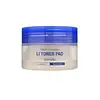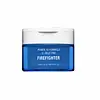What's inside
What's inside
 Key Ingredients
Key Ingredients

 Benefits
Benefits

 Concerns
Concerns

 Ingredients Side-by-side
Ingredients Side-by-side

Water
Skin ConditioningGlycyrrhiza Glabra Root Extract
BleachingSalix Alba Bark Extract
AstringentButylene Glycol
Humectant1,2-Hexanediol
Skin ConditioningBetaine
HumectantAllantoin
Skin ConditioningPanthenol
Skin ConditioningGlycolic Acid
BufferingChamomilla Recutita Flower Extract
MaskingAnanas Sativus Fruit Extract
Skin ConditioningTheobroma Cacao Seed Extract
AntioxidantSodium Hyaluronate
HumectantCapryloyl Salicylic Acid
ExfoliatingDipotassium Glycyrrhizate
HumectantHydroxypropyltrimonium Hyaluronate
Sodium Acetylated Hyaluronate
HumectantHydrolyzed Hyaluronic Acid
HumectantHyaluronic Acid
HumectantGuaiazulene
AntimicrobialSodium Hyaluronate Crosspolymer
HumectantHydrolyzed Sodium Hyaluronate
Skin ConditioningPotassium Hyaluronate
Skin ConditioningSodium Citrate
BufferingBetaine Salicylate
AntimicrobialPolyglyceryl-4 Caprate
EmulsifyingHydroxyethylcellulose
Emulsion StabilisingDipropylene Glycol
HumectantSodium Phytate
Dextrin
AbsorbentGluconolactone
Skin ConditioningJuniperus Mexicana Oil
MaskingRosa Damascena Flower Oil
MaskingPogostemon Cablin Leaf Oil
MaskingVetiveria Zizanoides Root Oil
MaskingWater, Glycyrrhiza Glabra Root Extract, Salix Alba Bark Extract, Butylene Glycol, 1,2-Hexanediol, Betaine, Allantoin, Panthenol, Glycolic Acid, Chamomilla Recutita Flower Extract, Ananas Sativus Fruit Extract, Theobroma Cacao Seed Extract, Sodium Hyaluronate, Capryloyl Salicylic Acid, Dipotassium Glycyrrhizate, Hydroxypropyltrimonium Hyaluronate, Sodium Acetylated Hyaluronate, Hydrolyzed Hyaluronic Acid, Hyaluronic Acid, Guaiazulene, Sodium Hyaluronate Crosspolymer, Hydrolyzed Sodium Hyaluronate, Potassium Hyaluronate, Sodium Citrate, Betaine Salicylate, Polyglyceryl-4 Caprate, Hydroxyethylcellulose, Dipropylene Glycol, Sodium Phytate, Dextrin, Gluconolactone, Juniperus Mexicana Oil, Rosa Damascena Flower Oil, Pogostemon Cablin Leaf Oil, Vetiveria Zizanoides Root Oil
Water
Skin ConditioningButylene Glycol
HumectantGlycerin
HumectantDipropylene Glycol
HumectantHydroxyacetophenone
AntioxidantCaprylyl Glycol
EmollientCaprylyl/Capryl Glucoside
CleansingPolyglyceryl-10 Laurate
Skin ConditioningAllantoin
Skin Conditioning1,2-Hexanediol
Skin ConditioningSodium Citrate
BufferingMelia Azadirachta Leaf Extract
Skin ConditioningMelia Azadirachta Flower Extract
Skin ConditioningChamomilla Recutita Flower Extract
MaskingCitric Acid
BufferingDisodium EDTA
Glycyrrhiza Glabra Root Extract
BleachingPolyglyceryl-10 Oleate
Skin ConditioningCoccinia Indica Fruit Extract
Skin ConditioningAloe Barbadensis Flower Extract
EmollientSolanum Melongena Fruit Extract
Skin ConditioningBetaine
HumectantDipotassium Glycyrrhizate
HumectantOcimum Sanctum Leaf Extract
Skin ConditioningCorallina Officinalis Extract
Skin ConditioningCurcuma Longa Root Extract
MaskingJuniperus Mexicana Oil
MaskingRosa Damascena Flower Oil
MaskingGuaiazulene
AntimicrobialPogostemon Cablin Leaf Oil
MaskingVetiveria Zizanoides Root Oil
MaskingWater, Butylene Glycol, Glycerin, Dipropylene Glycol, Hydroxyacetophenone, Caprylyl Glycol, Caprylyl/Capryl Glucoside, Polyglyceryl-10 Laurate, Allantoin, 1,2-Hexanediol, Sodium Citrate, Melia Azadirachta Leaf Extract, Melia Azadirachta Flower Extract, Chamomilla Recutita Flower Extract, Citric Acid, Disodium EDTA, Glycyrrhiza Glabra Root Extract, Polyglyceryl-10 Oleate, Coccinia Indica Fruit Extract, Aloe Barbadensis Flower Extract, Solanum Melongena Fruit Extract, Betaine, Dipotassium Glycyrrhizate, Ocimum Sanctum Leaf Extract, Corallina Officinalis Extract, Curcuma Longa Root Extract, Juniperus Mexicana Oil, Rosa Damascena Flower Oil, Guaiazulene, Pogostemon Cablin Leaf Oil, Vetiveria Zizanoides Root Oil
Ingredients Explained
These ingredients are found in both products.
Ingredients higher up in an ingredient list are typically present in a larger amount.
1,2-Hexanediol is a synthetic liquid and another multi-functional powerhouse.
It is a:
- Humectant, drawing moisture into the skin
- Emollient, helping to soften skin
- Solvent, dispersing and stabilizing formulas
- Preservative booster, enhancing the antimicrobial activity of other preservatives
Allantoin is a soothing ingredient known for its protective and moisturizingg properties. Because of this, it is often added to products with strong active ingredients.
Studies show higher concentrations of this ingredient can promote wound healing.
Though it can be derived from the comfrey plant, allantoin is produced synthetically for cosmetic products to ensure purity.
Learn more about AllantoinBetaine is a common humectant (a substance that promotes retention of moisture). It's known to be gentle on the skin and can help balance hydration.
This ingredient is best for improving hydration and soothing irritated skin. Studies also show it helps even out skin tone.
Fun fact: Betaine is naturally created in the skin and body. The kind found within cosmetic products can be either plant-derived or synthetic.
Another name for betaine is trimethylglycine.
Learn more about BetaineButylene Glycol (or BG) is used within cosmetic products for a few different reasons:
Overall, Butylene Glycol is a safe and well-rounded ingredient that works well with other ingredients.
Though this ingredient works well with most skin types, some people with sensitive skin may experience a reaction such as allergic rashes, closed comedones, or itchiness.
Learn more about Butylene GlycolChamomilla Recutita Flower Extract comes from the Chamomile flower.
Chamomile is rich in antioxidants and has anti-inflammatory properties. Several compounds found in chamomile help with soothing, such as bisbolol.
Antioxidant components in chamomile make it an effective ingredient to help slow the signs of aging. Antioxidants help fight free-radical molecules, or molecules that may damage your skin.
Essential oils from chamomile have been found to improve wound healing due to its antimicrobial properties.
Ancient Greeks and Egyptians used Chamomile to treat skin redness and dryness. Chamomile has also been used to help treat stomach issues.
Learn more about Chamomilla Recutita Flower ExtractDipotassium Glycyrrhizate comes from licorice root.
Extracts of licorice have demonstrated to have antibacterial, anti‐inflammatory, antiviral, antioxidant properties.
One component, glabridin, has extra potent antioxidant and soothing properties. It has also been found to block pigmentation from UVB rays in guinea pigs.
Licorice Root also contains a flavonoid. Flavonoids are a natural substance from in plants. Flavonoids also have antioxidant properties.
Another component, glycyrrhizin, has been found to have anti-inflammatory and antimicrobial benefits. This may make licorice root extract effective at treating acne. However, more research is needed to support this.
Liquiritin is one of the flavone compounds found in licorice. It has been found to help lighten skin by preventing tyrosinase from reacting with tyrosine. When the two react, protein is converted to melanin. Melanin is the substance in your body that gives your features pigmentation.
Licorice root is native to Southern Europe and Asia. It has been used in traditional Chinese medicine to help with respiratory issues.
Learn more about Dipotassium GlycyrrhizateDipropylene Glycol is a synthetically created humectant, stabilizer, and solvent.
This ingredient helps:
Dipropylene glycol is technically an alcohol, but it belongs to the glycol family (often considered part of the ‘good’ alcohols). This means it is hydrating and gentle on skin unlike drying solvent alcohols like denatured alcohol.
As a masking agent, Dipropylene Glycol can be used to cover the smell of other ingredients. However, it does not have a scent.
Studies show Dipropylene Glycol is considered safe to use in skincare.
Learn more about Dipropylene GlycolGlycyrrhiza Glabra Root Extract is an extract of the roots of Licorice. It has been found to have several benefits such as skin hydrating, conditioning, and soothing.
One component, glabridin, has extra potent antioxidant and soothing properties. It has also been found to block pigmentation from UVB rays in guinea pigs.
Licorice Root also contains a flavonoid. Flavonoids are a natural substance from in plants. Flavonoids also have antioxidant properties.
Another component, glycyrrhizin, has been found to have anti-inflammatory and antimicrobial benefits. This may make licorice root extract effective at treating acne. However, more research is needed to support this.
Liquiritin is one of the flavone compounds found in licorice. It has been found to help lighten skin by preventing tyrosinase from reacting with tyrosine. When the two react, protein is converted to melanin. Melanin is the substance in your body that gives your features pigmentation.
Learn more about Glycyrrhiza Glabra Root ExtractGuaiazulene is a fragrance.
Juniperus Mexicana Oil is an oil.
This ingredient is commonly known as Patchouli oil.
Patchouli exhibits slight antibacterial and antifungal activity from its patchoulol and alpha-patchoulene content.
However, it also contains known skin-irritating fragrances. A study from 2015 found limonene and camphor as active components of this ingredient.
Limonene and camphor are both known EU allergens.
Learn more about Pogostemon Cablin Leaf OilRosa Damascena Flower Oil is an essential oil made from the Damask Rose. It is often used as a fragrance in cosmetics.
Rose Oil has antibacterial and antioxidant properties due to its terpene, glycoside, flavonoid, anthocyanin, and Vitamin C content.
Other major parts of Rose Oil include citronellol and geraniol. Both of these are known EU allergens and cause contact-allergies.
The downsides of this ingredient outweight the positives.
Learn more about Rosa Damascena Flower OilSodium Citrate is the sodium salts of citric acid. In skincare, it is used to alter pH levels and acts as a preservative.
Its main functions are to maintain the pH of a product and neutralize metal ions.
The acidity of our skin is maintained by our glands and skin biome; normal pH level of skin is slightly acidic (~4.75-5.5).
Being slightly acidic allows our skin to create an "acid mantle". This acid mantle is a thin barrier that protects our skin from bacteria and contaminants.
Learn more about Sodium CitrateVetiver oil is known for its earthy fragrance. It is most often used for adding a scent or fragrance to a product.
Recent studies have found potential antioxidant activity of vetiver root oil.
Water. It's the most common cosmetic ingredient of all. You'll usually see it at the top of ingredient lists, meaning that it makes up the largest part of the product.
So why is it so popular? Water most often acts as a solvent - this means that it helps dissolve other ingredients into the formulation.
You'll also recognize water as that liquid we all need to stay alive. If you see this, drink a glass of water. Stay hydrated!
Learn more about Water